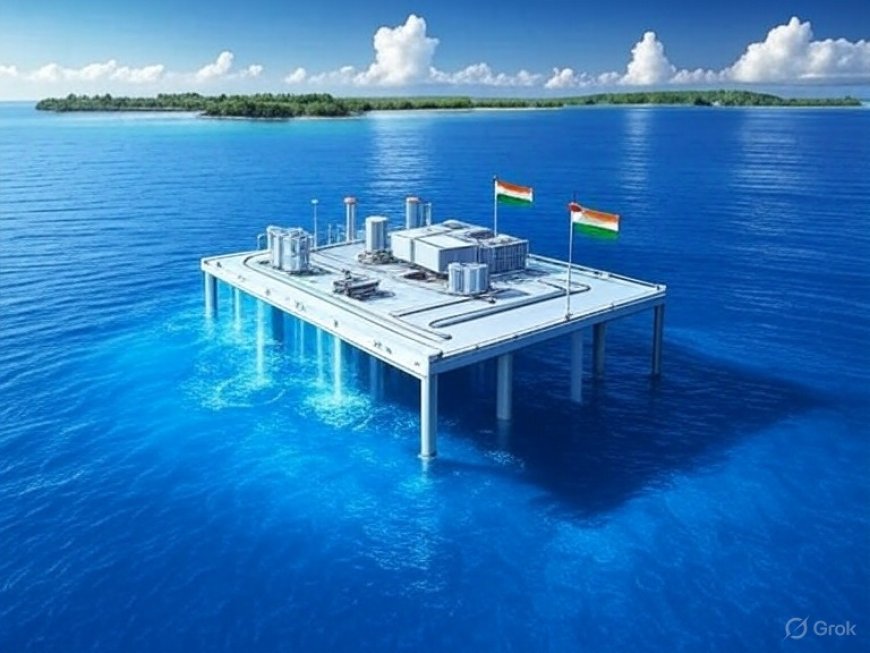India’s First Ocean Energy Pilot in Lakshadweep Could Transform Island Sustainability Forever
India's first OTEC pilot in Lakshadweep aims to generate clean energy and desalinated water from ocean temperature differences, paving the way for sustainable island development.

India is making waves in clean energy innovation with its first fully integrated Ocean Thermal Energy Conversion (OTEC) pilot project in Lakshadweep. Launched by the National Institute of Ocean Technology (NIOT) under the Ministry of Earth Sciences, this initiative aims to generate 165 kW of renewable power and 100,000 litres per day of desalinated water—directly from ocean thermal gradients—ushering in a potential revolution for remote island communities and coastal regions otecnews.org+13niot.res.in+13Tatsat Chronicle Magazine+13.
What Makes Lakshadweep’s OTEC Pilot a Landmark
Located off Kavaratti Island in water depths over 1,000 m, this offshore floating platform harnesses warm surface water (27–31 °C) and deep cold water (6–7 °C) to drive a closed-cycle Rankine engine—typically using ammonia—to produce electricity, before the cold water is used to desalinate seawater ocean-energy-systems.org+3niot.res.in+3Wikipedia+3. It’s the first time India has combined both power generation and desalination using OTEC on a floating platform, marking a leap over earlier low-temperature thermal desalination efforts that relied on diesel power Wikipedia.
Why OTEC Matters for Island Sustainability
Lakshadweep depends heavily on diesel generators and rainwater or reverse osmosis plants for freshwater—both expensive and unreliable solutions. This OTEC pilot promises a clean, continuous electricity supply, cutting diesel dependence while simultaneously offering freshwater without chemical treatment. By tapping the ocean’s temperature difference, the plant operates round-the-clock with minimal external energy input Tatsat Chronicle Magazine+6ThePrint+6The New Indian Express+6.
These islands have seen steady strides in solar installations, yet suffer from the intermittent nature of renewables. OTEC’s ability to operate 24/7 positions it as a vital complement, underpinning the region’s energy resilience and climate readiness.
Science Behind the System: Advanced Tech in Action
Engineering an offshore OTEC pilot is no small feat. The Kavaratti system uses a closed-cycle mechanism, where ammonia vaporizes in a warm-water evaporator, spins a turbine, and then condenses using cold deep-sea water niot.res.inocean-energy-systems.org. The platform is anchored over depths beyond 1 km while drawing water via deep-sea pipes made of durable HDPE, designed to withstand the harsh marine environment The New Indian ExpressResearchGate.
NIOT is collaborating with global partners—such as Saga University—to refine heat exchangers, pumps, and floating platform mechanics. This meticulous groundwork echoes earlier pilot designs laid out by NIOT and international researchers in the early 2000s otecnews.org+2ResearchGate+2ocean-energy-systems.org+2.
Policy Push: A Cornerstone of the Deep Ocean Mission
This project is a flagship under India’s Deep Ocean Mission, which aims to explore deep-sea living, robotics, and marine resources. NIOT’s OTEC plant has been financed through the Renewable Energy Research and Technology Development Programme, jointly overseen by the Ministry of New & Renewable Energy and Earth Sciences Ministry otecnews.org+4Press Information Bureau+4Tatsat Chronicle Magazine+4. Environmental clearance has been granted, with mandated ecological studies, especially for coral reefs, monitored by local forest authorities The New Indian Express.
Anticipated Regional and Global Impact
If successful, this pilot could redefine energy dynamics for islands worldwide. OTEC offers:
-
Stable, 24/7 clean power, unlike solar or wind.
-
Cost-effective desalination with no chemical by-products.
-
Enhanced energy independence for remote communities.
According to WRI India, ocean energy—including OTEC—could contribute significantly to India’s clean energy goals, backed by a favourable coastal geography and emerging policy environment Press Information BureauWRI India. For Lakshadweep's ~64,000 residents, this could spell reliable electricity, freshwater sufficiency, and a sustainable model for island living Wikipedia+1Wikipedia+1.
Challenges: What Must Be Addressed
Despite its promise, OTEC faces hurdles:
-
High capital cost: Large heat exchangers and submerged pipelines are expensive Wikipedia.
-
Engineering complexities: Deep-sea anchoring and resistance to storms require advanced materials and precise design niot.res.in+6Wikipedia+6Tatsat Chronicle Magazine+6.
-
Ecosystem concerns: Disruptions to deep-sea currents and coral habitats need close monitoring Wire & Cable India+4The New Indian Express+4Tatsat Chronicle Magazine+4.
-
Operational efficiency: Scaling from 0.165 MW to higher capacity requires R&D in turbine efficiency and cold-water intake systems Press Information Bureau+6ResearchGate+6WRI India+6.
Government support, pilot successes, and private-sector participation will be crucial in overcoming these challenges.
Scaling Up: What Comes Next
NIOT plans to share technical data as pilot performance is evaluated. If outcomes are positive, the Deep Ocean Mission aims for 10 MW OTEC plants and 5 MLD desalination facilities, either shore-based or floating niot.res.in+8ocean-energy-systems.org+8Tatsat Chronicle Magazine+8. Such scale-up could serve not just Lakshadweep—but also Andaman & Nicobar Islands, Tamil Nadu, and even strategic locations along the Indian coastline.
In global context, India’s OTEC breakthrough aligns with growing interest worldwide—especially for tropical regions where ocean temperature gradients are most favourable WRI India+6ResearchGate+6Tatsat Chronicle Magazine+6Wikipedia+1The New Indian Express+1.
Broader Benefits and Stakeholder Collaboration
Beyond power and water, the project opens economic and community avenues:
-
Local employment: Platform assembly, operations, and fisheries expansion.
-
Scientific advancement: Data from cold water systems can enhance oceanographic research.
-
Synergy with solar and wind: Hybrid microgrids incorporating OTEC could offer stable, low-carbon energy.
NIOT’s platforms can also support coastal climate resilience, by buffering wave energy and aiding in storm surge modelling.
A Model for Island Nations Worldwide
Island states from the Caribbean to the Pacific are exploring OTEC. India’s pilot—combining desalination with power—could serve as a global template. If extended, floating OTEC plants can provide lifelines in disaster-prone zones, affording renewable energy when ground systems fail.
Conclusion
India’s OTEC pilot in Lakshadweep is more than an intervention—it’s a statement that sustainable island living is achievable. Powered by ocean temperature differences, the project is a leap forward in reducing diesel reliance and securing freshwater for remote communities.
Success here could redefine the “Blue Economy”, showing that innovation and sustainability can thrive even at remote archipelagos. The silent depths of the Indian Ocean are becoming a frontier—one that could sustain energy and water needs for island communities not just in India, but across the world.


















































